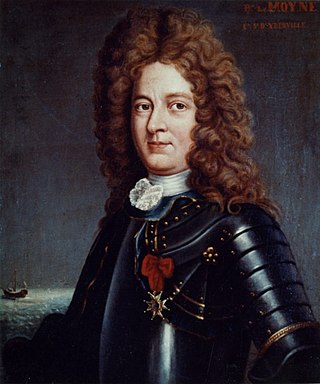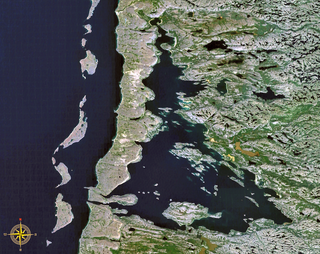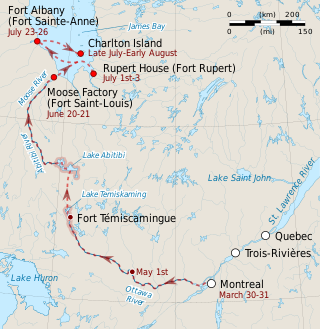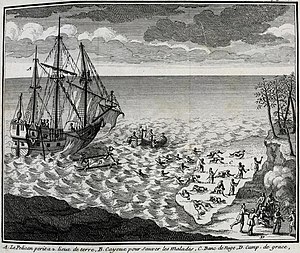
King William's War was the North American theater of the Nine Years' War (1688–1697), also known as the War of the Grand Alliance or the War of the League of Augsburg. It was the first of six colonial wars fought between New France and New England along with their respective Native allies before France ceded its remaining mainland territories in North America east of the Mississippi River in 1763.

Pierre Le Moyne d'Iberville or Sieur d'Iberville was a French soldier, explorer, colonial administrator, and trader. He is noted for founding the colony of Louisiana in New France. He was born in Montreal to French colonist parents.

York Factory was a settlement and Hudson's Bay Company (HBC) factory located on the southwestern shore of Hudson Bay in northeastern Manitoba, Canada, at the mouth of the Hayes River, approximately 200 kilometres (120 mi) south-southeast of Churchill.

The Pélican was a French warship from the late 17th century. Built in Bayonne, France, the original Pélican was launched in January 1693. A 500-ton ship fitted with 50 guns and commanded by Captain Pierre Le Moyne d'Iberville, she ran aground on the shores of Hudson Bay a few days after a heroic battle in 1697, badly damaged by the encounter and by a fierce storm. In five short months the ship's place in history had been assured, as the victor in the greatest naval battle in the history of New France.
Pierre Dugué de Boisbriand was a French Canadian soldier, politician, and aristocrat who commanded several areas in North America colonized by New France in the early 18th Century and who served as the seventh governor of the French colony of Louisiana.

Philippe Pastour de Costebelle was a French naval officer and Governor of Newfoundland and then Louisbourg. He was born in Languedoc, France and died in Louisbourg, New France.
Pierre de Troyes was a captain that led the French capture of Moose Factory, Rupert House, and Fort Albany on Hudson Bay 1686.

Fort Maurepas, later known as Old Biloxi, was developed in colonial French Louisiana in April 1699 along the Gulf of Mexico . Fort Maurepas was designated temporarily as the capital of Louisiana in 1699. The capital was moved from Ocean Springs to Mobile in 1710, then to New Orleans in 1723 on the Mississippi River. Government buildings in the latter city were still under construction.
The Compagnie du Nord was a French colonial fur-trading company, founded in Québec City 1682 by a group of Canadien financiers with the express intent of competing with the English Hudson's Bay Company. It was founded by Charles Aubert de La Chesnaye with the assistance of Pierre-Esprit Radisson and his brother-in-law Médard Chouart des Groseilliers.

Lake Tasiujaq is a large triangular-shaped inland bay located on east side of Hudson Bay just above 56th parallel north in Quebec, Canada. It was formerly known as Richmond Gulf in English and Lac Guillaume-Delisle in French.

Lefebvre's Charles Town expedition was a combined French and Spanish attempt under Captain Jacques Lefebvre to capture the capital of the English Province of Carolina, Charles Town, during Queen Anne's War.
D'Iberville is a Canadian dramatic adventure television series which aired on Radio-Canada in 1967 and 1968, and on CBC Television's English network from 1968 to 1969.

The Hudson Bay expedition of 1686 was one of the Anglo-French conflicts on Hudson Bay. It was the first of several expeditions sent from New France against the trading outposts of the Hudson's Bay Company in the southern reaches of Hudson Bay. Led by the Chevalier de Troyes, the expedition captured the outposts at Moose Factory, Rupert House, Fort Albany, and the company ship Craven.

The 1688 Battle of Fort Albany was one of the Anglo-French conflicts on Hudson Bay. In the Hudson Bay expedition (1686) the French had, in time of peace, marched overland from Quebec and captured all three English posts on James Bay. The French had left a garrison at Fort Albany and needed to send a ship to resupply it and take out the furs. The Hudson's Bay Company learned of its loss in January 1687 and appealed to the king. This led to about a year of diplomatic negotiations. In 1688 the Company sent five ships to the Bay. Two went to its remaining post at York Factory, one went to reestablish Rupert House which the French had burned and two went to Fort Albany on the west shore of James Bay. Their instructions were to re-establish the English trade and not to use force against the French unless the French did so first.

The Capture of York Factory was a 1694 Anglo-French conflict on Hudson Bay. In 1686 Pierre Le Moyne d'Iberville marched overland from Québec and captured all the English posts on James Bay. This left York Factory, which was too far away and could only be reached by sea. In 1688 King William's War started and the needed ships were hard to get. In 1690 Iberville tried to take York Factory but was driven away by a larger English ship. In 1694 Governor Frontenac gave him the ships Salamandre and Poli. Iberville reached the Nelson River on 14 September. The fort was invested and on 14 October it surrendered..

The Naval battle off St. John took place on July 14, 1696, between France and England toward the end of King William's War in the Bay of Fundy off present-day Saint John, New Brunswick. The English ships were sent from Boston to interrupt the supplies being taken by French officer Pierre Le Moyne d'Iberville from Quebec to the capital of Acadia, Fort Nashwaak on the Saint John River. The French ships of war Envieux and Profond captured the English frigate Newport, while the English frigate Sorlings and a provincial tender escaped.

The Avalon Peninsula campaign occurred during King William's War when forces of New France, led by Pierre Le Moyne d'Iberville and Governor Jacques-François de Monbeton de Brouillan, destroyed 23 English settlements along the coast of the Avalon Peninsula, Newfoundland in the span of three months. The campaign began with raiding Ferryland on November 10, 1696, and continued along the coast until they raided the village of Heart's Content.
Jacques Le Moyne de Sainte-Hélène was a Canadian soldier who was born on April 16, 1659, in Montréal. He was the son of Charles Le Moyne and Catherine Thierry. He died in Quebec City in 1690.
Antoine Le Moyne de Châteauguay was a French soldier and colonial administrator who assisted in the foundation of the French colony of Louisiana in 1699–1702. He served in various posts in Mobile, Louisiana and Martinique. He was governor of Cayenne from 1738 to 1743, then governor of Île Royale from 1745.















